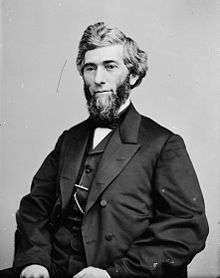Reuben Fenton
| Reuben Eaton Fenton | |
|---|---|
 | |
| Member of the U.S. House of Representatives from New York's 33rd district | |
|
In office March 4, 1853 – March 3, 1855 | |
| Preceded by | Augustus P. Hascall |
| Succeeded by | Francis S. Edwards |
|
In office March 4, 1857 – March 3, 1863 | |
| Preceded by | Francis S. Edwards |
| Succeeded by | Nelson I. Norton |
| Member of the U.S. House of Representatives from New York's 31st district | |
|
In office March 4, 1863 – December 20, 1864 | |
| Preceded by | Burt Van Horn |
| Succeeded by | Henry Van Aernam |
| 22nd Governor of New York | |
|
In office January 1, 1865 – December 31, 1868 | |
| Lieutenant |
Thomas G. Alvord (1865–1866) Stewart L. Woodford (1867–1868) |
| Preceded by | Horatio Seymour |
| Succeeded by | John T. Hoffman |
| United States Senator from New York | |
|
In office March 4, 1869 – March 3, 1875 | |
| Preceded by | Edwin D. Morgan |
| Succeeded by | Francis Kernan |
| Personal details | |
| Born |
July 4, 1819 Carroll, New York, U.S. |
| Died |
August 25, 1885 (aged 66) Jamestown, New York, U.S. |
| Political party | Republican |
Reuben Eaton Fenton (July 4, 1819 – August 25, 1885) was an American merchant and politician from New York.
Life
.png)
The son of a farmer, Fenton was born near Frewsburg, in Chautauqua County, New York. He was elected a colonel of the New York State Militia in 1840. He became a lumber merchant, but also studied law and was admitted to the bar in 1841.[1] Fenton entered politics as a Democrat. He was Town Supervisor of Carroll from 1843 to 1850.
He was elected as a Democrat to the 33rd United States Congress, and served from March 4, 1853, to March 3, 1855. In his first term in Congress, Fenton strongly opposed the Kansas-Nebraska Act of 1854 and unsuccessfully tried to persuade President Franklin Pierce and U.S. Secretary of State William L. Marcy to oppose the bill. He was defeated for re-election that year. He left the Democratic Party to help organize the Republican Party,[1] and was later elected, as a Republican, to the 35th, 36th, 37th and 38th United States Congresses, and served from 1857 to 1865.
He was Governor of New York from 1865 to 1868, elected in 1864 and 1866. In 1868, he was among the candidates to be Vice President but the nomination went eventually to Schuyler Colfax. In January 1869, he was elected a U.S. Senator from New York and served from 1869 to 1875. In 1872 he was among the Republicans opposed to President Ulysses S. Grant who joined the short-lived Liberal Republican Party.

In 1878, Fenton represented the United States at the international monetary conference in Paris. He was known as "The Soldiers' Friend" for his efforts to help returning Civil War veterans. He worked to remove tuition charges for public education, helped to establish six schools for training teachers, and signed the charter for Cornell University.
Legacy
After his death, a building at The State University of New York at Fredonia, Fenton Hall, was named in his honor because he had attended the previous incarnation of the school, the Fredonia Academy.
His former home in Jamestown is the site of the Fenton History Center. It was listed on the National Register of Historic Places in 1972.[2]
Fenton Avenue in The Bronx, New York, is named for him.
References
- 1 2 "Reuben Eaton Fenton Papers, 1854-1887 (finding aid)". New York State Library web site. New York State Library. Retrieved 25 November 2014.
- ↑ National Park Service (2009-03-13). "National Register Information System". National Register of Historic Places. National Park Service.
External links
| Wikimedia Commons has media related to Reuben Fenton. |
- Mr. Lincoln and New York: Reuben E. Fenton
- Google Book Life Sketches of State Officers, Senators, and Members of Assembly in the State of New York in 1867 by S. R. Harlow and H. H. Boone (Weed, Parsons & Co., Albany NY, 1867)
- United States Congress. "Reuben Fenton (id: F000077)". Biographical Directory of the United States Congress.
| United States House of Representatives | ||
|---|---|---|
| Preceded by Augustus P. Hascall |
Member of the U.S. House of Representatives from New York's 33rd congressional district March 4, 1853 – March 4, 1855 |
Succeeded by Francis S. Edwards |
| Preceded by Francis S. Edwards |
Member of the U.S. House of Representatives from New York's 33rd congressional district March 4, 1857 – March 4, 1863 |
District eliminated |
| Preceded by Burt Van Horn |
Member of the U.S. House of Representatives from New York's 31st congressional district March 4, 1863 – December 20, 1864 |
Succeeded by Henry Van Aernam |
| Political offices | ||
| Preceded by Horatio Seymour |
Governor of New York 1865–1868 |
Succeeded by John T. Hoffman |
| United States Senate | ||
| Preceded by Edwin D. Morgan |
U.S. Senator (Class 1) from New York 1869–1875 Served alongside: Roscoe Conkling |
Succeeded by Francis Kernan |

